
Kingsville is a semi-rural, unincorporated community and census-designated place in Baltimore County, Maryland, United States. It is a close-knit and rustic community bounded by the Little Gunpowder Falls river and the Big Gunpowder Falls river which join to form the Gunpowder River. The population of Kingsville was 4,318 at the 2010 census.

Joppatowne is a census-designated place in southwestern Harford County, Maryland, United States. Serving as a bedroom community for nearby Baltimore, it was established in 1961 as a planned unit development (PUD). The population was 12,616 at the 2010 census, up from 11,391 in 2000.

Brandywine Creek is a tributary of the Christina River in southeastern Pennsylvania and northern Delaware in the United States. The Lower Brandywine is 20.4 miles (32.8 km) long and is a designated Pennsylvania Scenic River with several tributary streams. The East Branch and West Branch of the creek originate within 2 miles (3 km) of each other on the slopes of Welsh Mountain in Honey Brook Township, Pennsylvania, about 20 miles (32 km) northwest of their confluence.
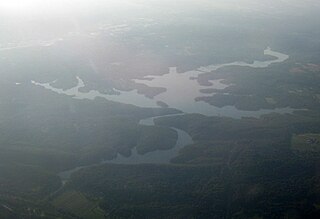
The Gunpowder River is a 6.8-mile-long (10.9 km) tidal inlet on the western side of the Chesapeake Bay in Maryland, United States. It is formed by the joining of two freshwater rivers, Gunpowder Falls and Little Gunpowder Falls.
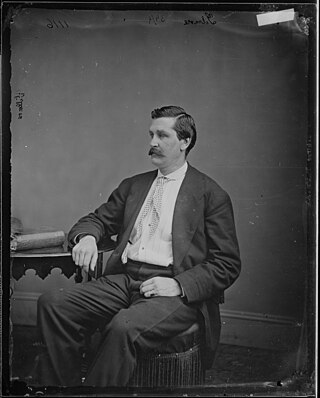
Harry Ward Gilmor served as the Baltimore City Police Commissioner, head of the Baltimore City Police Department in the 1870s, and a Confederate cavalry officer during the American Civil War. Gilmor's daring raids, including Gilmor's Raid through northern and central Maryland in July 1864 during the third major Confederate invasion of the North gained his partisans fame as "Gilmor's Raiders".

There are more than 1,500 properties and districts listed on the National Register of Historic Places in the U.S. State of Maryland. Each of the state's 23 counties and its one county-equivalent has at least 20 listings on the National Register.

The Tuthilltown Gristmill is located off Albany Post Road in Gardiner, New York, United States. It was built in 1788, as the National Register reports, and has been expanded several times since.
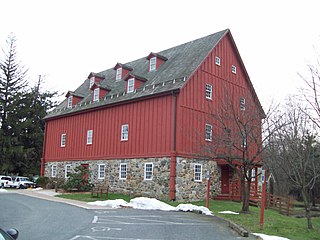
Gunpowder Falls State Park is a public recreation area comprising six non-contiguous areas covering 18,000 acres (7,300 ha) in northeastern Baltimore County and western Harford County, Maryland. The state park is primarily made up of the stream valleys of the Big and Little Gunpowder Falls and the Gunpowder River; its natural features range from tidal marshes to rugged interior slopes. The park has over 120 miles of trails for hiking, biking, horseback riding, and cross-country skiing plus facilities for picnicking, tubing, canoeing and kayaking, tide-water fishing and crabbing, fly fishing, and hunting, among other activities. It is managed by the Maryland Department of Natural Resources.

Gilmor's Raid, also known as The Magnolia Station Train Raid, was a foraging and disruptive cavalry raid that was part of an overall campaign against Union railroads, led by Maj. Harry W. Gilmor with 135 men from the First and Second Maryland Cavalry regiments. It was authorized by Confederate Lt. Gen. Jubal Early during his Valley Campaigns of 1864, which threatened Washington, D.C., during the American Civil War.

St. James Church is a historic Episcopal church located at Monkton, Baltimore County, Maryland, US.

Jericho Farm is a historic home located near Kingsville, Baltimore County, Maryland, near historic Jerusalem Mill Village. It is a large 2+1⁄2-story gable-roofed stone 25 by 30-foot dwelling house, it had an adjoining commodious stone kitchen; with a piazza, pump, garden, yard, barn, stables, meat house, and a spring overlooking the Little Gunpowder Falls.
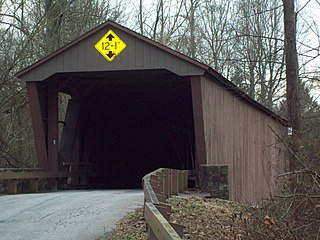
The Jericho Covered Bridge is a Burr arch through truss wooden covered bridge near Jerusalem, Harford County and Kingsville, Baltimore County, in Maryland, United States and near historic Jerusalem Mill Village. The bridge was constructed in 1865 across the Little Gunpowder Falls. This bridge is 88 feet (27 m) long and 14.7 feet (4.5 m) wide and is open to traffic.
Jerusalem is an unincorporated community in Harford County, Maryland, United States. It is the location of the historic Jerusalem Mill Village and Jericho Covered Bridge, both listed on the National Register of Historic Places. Jerusalem Mill Village is located on Jerusalem Road in Kingsville, MD between the Little Gunpowder Falls river and Jericho Road.

Rockland Historic District is a national historic district at Brooklandville, Baltimore County, Maryland, United States. It is located at the intersection of Old Court Road and Falls Road, where Old Court turns into Ruxton Road. There are 15 buildings in the area, including a general store, tavern, the shell of a blacksmith shop, a carriage house, several log buildings, a group of stone rowhouses, the Rockland Grist Mill, and an 18th-century dwelling. It is one of the surviving examples of a small, quiet, sylvan community of the early 19th century.

Whitaker's Mill Historic District is a national historic district near Joppa, Harford County, Maryland, United States. It includes three early- to mid-19th-century buildings: the 2+1⁄2-story rubble stone Whitaker's Mill built in 1851, the 1+1⁄2-story rubble stone miller's house, and the log-and-frame Magness House, begun about 1800 as the miller's house for the first mill on the site. The district also includes an iron truss bridge known as Harford County Bridge No. 51, constructed in 1878, and the oldest such span in the county. The grist mill closed operations about 1900.

The Newlin Mill Complex, also referred to as The Newlin Grist Mill, is a water-powered gristmill on the west branch of Chester Creek near Concordville, Pennsylvania built in 1704 by Nathaniel and Mary Newlin and operated commercially until 1941. During its three centuries of operation, the mill has been known as the Lower Mill, the Markham Mill, the Seventeen-O-Four Mill and the Concord Flour Mill. In 1958 the mill property was bought by E. Mortimer Newlin, restored and given to the Nicholas Newlin Foundation to use as a historical park. Water power is still used to grind corn meal which is sold on site. The park includes five historical buildings, which were added to the National Register of Historic Places in 1983, and 150 acres (61 ha) of natural woodland.
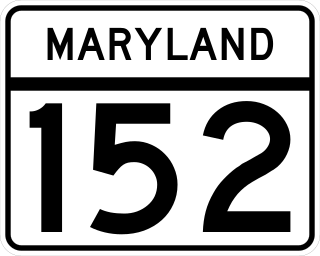
Maryland Route 152 is a state highway in the US state of Maryland. The state highway runs 17.34 miles (27.91 km) from an entrance to Aberdeen Proving Ground in Edgewood north to MD 146 near Taylor. MD 152 parallels the western edge of Harford County, connecting the communities of Joppatowne and Fallston with Interstate 95 (I-95), U.S. Route 40, and US 1. The state highway north of Joppa was mostly built in the late 1920s and early 1930s. MD 152 south of Joppa was built around 1940; shortly thereafter, the highway was reconstructed as a wartime access project. The state highway originally had only a partial interchange with I-95; it was expanded to full interchange in the mid 1990s concurrent with the expansion of the highway to a four-lane divided highway through Joppa.

Spring Mill is an unincorporated community in Whitemarsh Township, Montgomery County, Pennsylvania, United States.
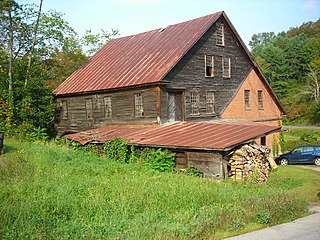
The Hayward and Kibby Mill, also known as the Tunbridge Mill, is a historic industrial facility on Spring Road in Tunbridge, Vermont. It includes a substantially complete water-powered 19th-century grist mill dating back to 1820, with a later sawmill added about 1870. It is one of the few surviving water-powered mills in the state, and is believed to be the only one featuring both a sawmill and grist (grain) mill. It was listed on the National Register of Historic Places in 1992.
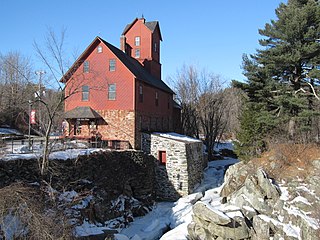
The Jericho Village Historic District encompasses the historic industrial and commercial center of the village of Jericho, Vermont. Stretched along Vermont Route 15 south of Browns River, which powered the village's industries for many years, the village center includes a well-preserved array of 19th and early 20th-century buildings. The district was listed on the National Register of Historic Places in 1992.
































